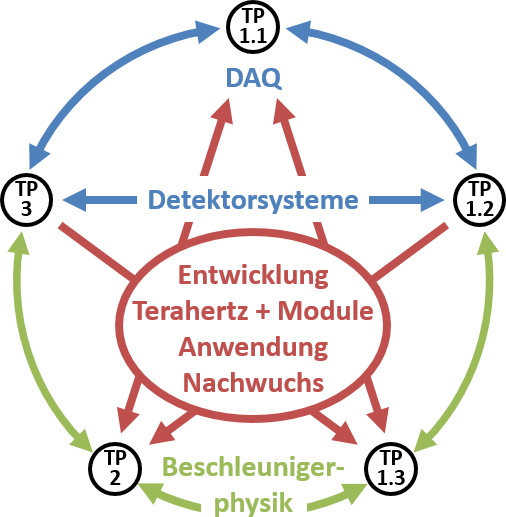
NeoDyn
- contact:
- funding:
BMBF
- Partner:
KIT-IEKP (AP: Michele Caselle, PL: Marc Weber)
KIT-IMS (AP: Alexander Schmid, PL: Michael Siegel)
KIT-LAS (AP: Gudrun Niehues, PL: Anke-Susanne Müller / Verbundsprecherin)
TU Dortmund (AP, PL: Shaukat Khan)
TU Dresden (AP, PL: Niels Neumann)
- startdate:
01.07.2016
- enddate:
30.06.2019
Advanced beam diagnostics detectors and technologies for future accelerators. Special emphasis is put on short-pulse physics and diagnostics. Our research benefits from the close collaboration of KIT accelerator and detector specialists. An example for the strength of this concept is the development of the novel beam diagnostics systems KAPTURE and KALYPSO.
The team at KIT has developed and is evaluating various THz detectors for beam diagnostics. In addition, electro-optical modulation is used to further characterize the beam. For both techniques, readout measurement electronics have been developed to continuously monitor the electron beam. These systems are unique in the community: it is now possible to record each individual beam without interruption up to high repetition rates. This overcomes the current limitations of optical and electronic methods and data acquisition. In particular, the envisioned modular, high resolution, high repetition rate, THz detection systems can provide the enabling technologies to facilitate advanced accelerator control, which will increase the efficiency of current and future photon sources. The proposed research will contributence accelerator research and open new windows of opportunities in research with photons and user experiments. This is particularly relevant for light sources delivering photon pulses from pico- to femtoseconds, such as BESSY II, FELBE/TELBE and FLASH/XFEL, KARA/FLUTE.
Electron beam diagnostic instruments combine challenging technology to reach the limits of resolution. For example, superconducting sensors and special semiconductor designs are used for the detectors. Analog circuit technology is integrated into specific ASIC, high frequency effects have to be considered, interconnect technologies for high integration densities are needed and the resulting data rate has to be processed stepwise, e.g. with AI algorithms. Within the NeoDyn project, we developed a new generation of innovative detector systems for accelerator diagnostics. The goal of the overall project was to open up new possibilities for accelerator physics.
In the course of the project, unique detector systems were manufactured and installed, which significantly extended the measurement technology and thus led to new or improved applications in the THz range and for short electron and photon pulses at large facilities. For the investigation of the THz behaviour with a temporal resolution in the picosecond range and the possibility to continuously observe the interactions between electron bunches, the detector readout electronics KAPTURE was developed. The line scan camera KALYPSO was originally designed for the measurement of electro-optical spectra at the KIT research synchrotron KARA, and was later also used at the European XFEL and at FLASH, ELBE and DELTA. Both systems are characterized by: 1) their modularity; both systems can be used as stand-alone detectors or integrated into a MicroTCA rack, 2) they combine high resolution with high measurement frequency, 3) they have the capability for very comprehensive and flexible monitoring and control of synchrotron, linear and plasma accelerators.
Technologies
- Beam diagnostics for accelerators
- Neural networks for accelerator physics

